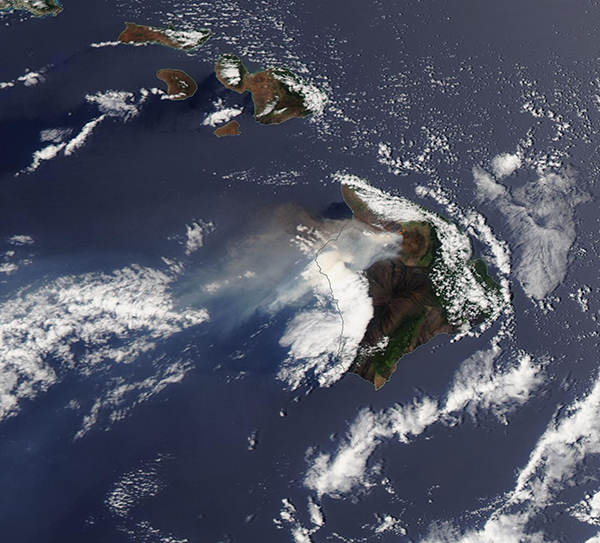Images
August 3, 2020 - Taklimakan Desert
Tweet
According to one popular travel website, China’s Taklimakan Desert “is considered to be one of the world’s most hostile wastelands”. That may be slightly overstating the case—a few nomadic peoples have traditionally forayed into parts of this sandy desert or eked out a living along its edge—but it’s not far from the truth. Roughly the size of Germany, the Taklimakan is China’s hottest, driest, and largest desert, filled with shifting sand dunes which soar up to 650-900 feet (200-300 meters) in height. The desert sits in the Tarim Basin and is surrounded by the snow-covered Tian Shan mountains in the north and the rugged Kunlun Mountains in the south.
During the Han Empire (206 BCE-220 CE) and for about 1,5000 years after, the Silk Road skirted the edges of the Taklamakan, with water-rich oases at the edge offering welcome points to stop and rest for the numerous caravans carrying goods between the East and the West. Indeed, research suggests that at the beginning of the Han Empire, at least some parts of the desert were relatively moist, supporting many thriving cities, especially in the Lop Nur area of the eastern basin. The dwellings were abandoned between 220 CE and 645 CE at a time when increased amount of sand was piling up, suggestive of increasing desertification. Despite the relatively moister conditions, the Silk Road caravans of the time still avoided the perils of travel in the vast sandy desert. In the local Ugyur language, the term Taklimakan roughly translates to “you go in, but you don’t come out”.
On July 28, 2020, the Moderate Resolution Imaging Spectroradiometer (MODIS) on board NASA’s Aqua satellite acquired a true-color image of the Taklimakan Desert.
Ringed by snow-covered mountains, the sand seas of the Taklamakan are colored in camel-colored tan. Thanks primarily from snowmelt from the mountains, several areas at the edges of the desert have greened with vegetation. The Hotan River, formed at the confluence of the White Jade and the Black Jade river in the south, flows northward across the desert.
Image Facts
Satellite:
Aqua
Date Acquired: 7/28/2020
Resolutions:
1km (265.7 KB), 500m (693 KB), 250m (454.3 KB)
Bands Used: 1,4,3
Image Credit:
MODIS Land Rapid Response Team, NASA GSFC
Tweet
According to one popular travel website, China’s Taklimakan Desert “is considered to be one of the world’s most hostile wastelands”. That may be slightly overstating the case—a few nomadic peoples have traditionally forayed into parts of this sandy desert or eked out a living along its edge—but it’s not far from the truth. Roughly the size of Germany, the Taklimakan is China’s hottest, driest, and largest desert, filled with shifting sand dunes which soar up to 650-900 feet (200-300 meters) in height. The desert sits in the Tarim Basin and is surrounded by the snow-covered Tian Shan mountains in the north and the rugged Kunlun Mountains in the south.
During the Han Empire (206 BCE-220 CE) and for about 1,5000 years after, the Silk Road skirted the edges of the Taklamakan, with water-rich oases at the edge offering welcome points to stop and rest for the numerous caravans carrying goods between the East and the West. Indeed, research suggests that at the beginning of the Han Empire, at least some parts of the desert were relatively moist, supporting many thriving cities, especially in the Lop Nur area of the eastern basin. The dwellings were abandoned between 220 CE and 645 CE at a time when increased amount of sand was piling up, suggestive of increasing desertification. Despite the relatively moister conditions, the Silk Road caravans of the time still avoided the perils of travel in the vast sandy desert. In the local Ugyur language, the term Taklimakan roughly translates to “you go in, but you don’t come out”.
On July 28, 2020, the Moderate Resolution Imaging Spectroradiometer (MODIS) on board NASA’s Aqua satellite acquired a true-color image of the Taklimakan Desert. Ringed by snow-covered mountains, the sand seas of the Taklamakan are colored in camel-colored tan. Thanks primarily from snowmelt from the mountains, several areas at the edges of the desert have greened with vegetation. The Hotan River, formed at the confluence of the White Jade and the Black Jade river in the south, flows northward across the desert.
Image Facts
Satellite:
Aqua
Date Acquired: 7/28/2020
Resolutions:
1km (265.7 KB), 500m (693 KB), 250m (454.3 KB)
Bands Used: 1,4,3
Image Credit:
MODIS Land Rapid Response Team, NASA GSFC




